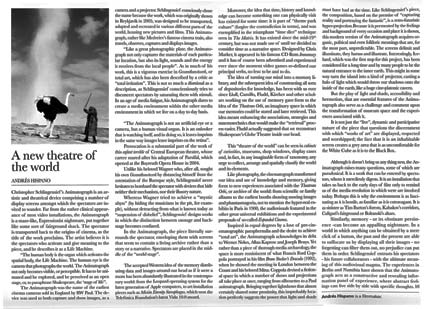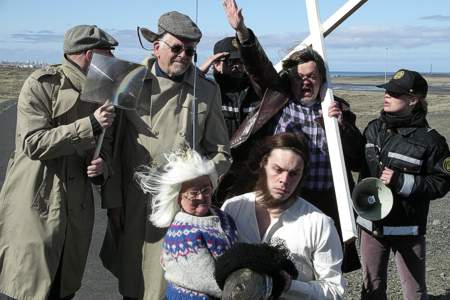 |
 |
|
 |
 |
A new theatre of the world
(Art&Co Numero 2, Primavera 2008)
Christopher Schlingensief's Animatograph is an artistic and theatrical device comprising a number of display screens amongst which the spectators are invited to wander. Far from the rather clinical appearance of most video installations, the Animatograph is a maze-like, Expressionist nightmare, put together like some sort of fairground shack. The spectator is transported back to the origins of cinema, as the title of the work proclaims. The artist believes it is the spectators who activate and give meaning to the piece, and he describes it as a Life Machine.
 |
| A new theatre of the world: Artikel als JPEG herunterladen (1.3 MB) |
"The human body is the organ which activates the spatial body, the Life Machine. The human eye is the camera that photographs the world. The Animatograph not only becomes visible, or perceptible. It has to be animated and be explored, and be perceived as an open stage, or, to paraphrase Shakespeare, the 'stage of life".
The Animatograph was the name of the earliest cinema cameras sold in England by RW Paul. The device was used to both capture and show images, as a camera and a projector. Schlingensief consciously chose the name because the work, which was originally shown in Reykjavik in 2005, was designed to be transported, adapted and recreated in various different parts of the world, housing new pictures and films. This Animatograph, rather like Medveiev's famous cinema train, also travels, observes, captures and displays images.
 |
| Schlingensiefs Animatograph - Island Edition, Reykjavik, 2005 |
"Like a great photographic plate, the Animatograph not only captures the materials of each particular location, but also its light, sounds and the energy it receives from the local people". As in much of his work, this is a vigorous exercise in Gesamtkunstwerk, or total art, which has also been described by a critic as "total irritation". This is not so much a dismissal as a description, as Schlingensief conscientiously tries to disconcert spectators by saturating them with stimuli. In an age of media fatigue, his Animatograph dares to create a media environment within the other media environment in which we live on a day to day basis.
"The Animatograph is not an artificial eye or a camera, but a human visual organ. It is an onlooker that is watching itself, and in doing so, it leaves imprints in the same way images leave imprints on the retina".
Provocation is a substantial part of the work of this enfant terrible of Central European theatre, whose career soared after his adaptation of Parsifal, which opened at the Bayreuth Opera House in 2004.
Unlike his beloved Wagner who, after all, sought his own Gesamtkunstwerk by distancing himself from the ostentation of the Baroque style, Schlingensief never hesitates to bombard the spectator with devices that hide neither their mechanism, nor their illusory nature.
 |
| Schlingensiefs Animatograph - Island Edition, Reykjavik, 2005 |
Whereas Wagner tried to achieve a "mystic abyss" (by hiding the musicians in the pit, for example), without detracting from what is known today as "suspension of disbelief", Schlingensief designs works in which the distinction between onstage and backstage becomes confused.
In the Animatograph, the piece literally surrounds the spectator, enveloping them with screens that seem to contain a living archive rather than a story or a narrative. Spectators are placed in the middle of the "world stage".
The accepted Western idea of the memory distributing data and images around our head as if it were a room has been abundantly illustrated in the contemporary world: from the Leopard operating system for the latest generation of Apple computers, to art installation pieces such as Misión Eternity Sarcophagus, which won the Telefónica Foundation's latest Vida 10.0 award.
Moreover, the idea that time, history and knowledge can become something one can physically visit has existed for some time: it is part of "theme park culture" (forgive the contradiction in terms), and was exemplified in the triumphant "time slice" technique seen in The Matrix. It has existed since the mid-19th century, but was not made use of until we decided to consider time as a narrative space. Designed by Chris Marker, it appeared in his famous CD Rom Immemory and it has of course been advertised and experienced ever since the moment video games re-defined our principal verbs, no less: to be and to do.
 |
| Schlingensiefs Animatograph - Island Edition, Reykjavik, 2005 |
The idea of turning our mind into a memory library, and the subsequent idea of constructing all sorts of depositories for knowledge, has been with us ever since Llull, Camillo, Fludd, Kircher and other scholars working on the use of memory gave form to the idea of the Theatrum Orbi, an imaginary space in which our memories could be stored and later retrieved. This idea meant enhancing the associations, strategies and mnemotechnics that would make the "retrieval" process easier. Fludd actually suggested that we reconstruct Shakespeare's Globe Theatre inside our head.
This "theatre of the world" can be seen in cabinets of curiosities, museums, shop windows, display cases and, in fact, in any imaginable form of taxonomy, any urge to collect, arrange and spatially classify the world and its elements.
Like photography, the cinematograph transformed our idea and use of knowledge and memory giving form to new experiences associated with the Theatrum Orbi, or archive of the world: from scientific or family albums to the earliest booths showing moving images and phantasmagoria, not to mention the hyper-real exhibits in Paris in 1900, the audiovisuals featured in the other great universal exhibitions and the experimental proposals of so-called Expanded Cinema.
Inspired in equal degrees by a love of pre-cinematographic paraphernalia and the desire to achieve "total art", the Animatograph acknowledges its debt to Werner Nekes, Allan Kaprow and Joseph Beuys. Yet rather than a piece of thorough media archaeology, the space is more reminiscent of what Francis Ford Coppola portrayed in his film Bram Stocker's Dracula (1992), when he showed the meeting in London between the Count and his beloved Mina. Coppola devised a fictional space in which a number of shows and projections all take place at once, ranging from silhouettes to a Paul animatograph. Bringing together lightshows that almost certainly shared some proximity, this improbably location perfectly suggests the power that light and shade must have had at the time. Like Schlingensief's piece, the composition, based on the premise of "capturing reality and portraying the fantastic", is a retro-futuristic hyper-projection. Because it is permeated by the feelings and background of every occasion and place it is shown, this modern version of the Animatograph acquires organic, political and even folkloric meanings that are, for the most part, unpredictable. The screens delimit and illuminate, they harass and illustrate. Interestingly, Iceland, which was the first stop for this project, has been considered for a long time and by many people to be the natural entrance to the inner earth. This might in some way turn the island into a kind of projector, casting a halo of light which would throw our shadows onto the inside of the earth, like a huge cine-platonic cavern.
 |
| Schlingensiefs Animatograph - Island Edition, Reykjavik, 2005 |
But the play of light and shade, accessibility and hermetism, that are essential features of the Animatograph also serve as a challenge and comment upon the transformation of museum space and the experiences associated with it.
It is not just the "live", dynamic and participative nature of the piece that questions the discernment with which "works of art" are displayed, respected and worshipped; the fact that it is an inhabitable screen creates a grey area that is as uncomfortable for the White Cube as it is to the Black Box.
Although it doesn't bring us any thing new, the Animatograph raises many questions, some of which are paradoxical. It is a work that can be entered by spectators, whom it mercilessly digests. It is an installation that takes us back to the early days of film only to remind us of the media revolution in which were are involved today. Perhaps this is why the environment is as fascinating as it is hostile, as familiar as it is extravagant. It is as sinister as Tim Burton's forests, Kabakov's corridors, Caligari's fairground or Boltanski's altars.
Similarly, memory - or its obstinate persistence -can become an appalling nightmare. In a world in which anything can be obtained by a mere click of a button, the past and the present are able to suffocate us by displaying all their images - no forgetting can filter them out, no prejudice can put them in order. Schlingensief entrusts his spectators - his future collaborators - with the ultimate meaning of this audiovisual magma. The experiences in Berlin and Namibia have shown that the Animatograph acts as a constructive and revealing information panel of experience, where abstract feelings can live side by side with specific thoughts.
Andres Hispano is a filmmaker.
Materialübersicht zu Schlingensiefs Animatographen
|
 |
 |
 |
 |
Der Animatograph
- 1. Übersicht
- 2. Einleitung
- A new theatre of the
world (Art & Co 2/08)
- 3. Theorie
- ANIMATOGRAPH IV
- ANIMATOGRAPH III
- ANIMATOGRAPH II
- ANIMATOGRAPH I
Bilderstrecken
- Animatograph-Galerie
- Island-Dreh-Galerie II
- Island-Dreh-Galerie I
Flugblätter
- Außerparl. Obsession
- Icelandic Party
- Icelandic Army
- Gene Database
Verwandte Projekte
- Der Animatograph
Deutschland Edition
- Der Animatograph
Afrika Edition
Externe Links
- T-B A21
- Hauser & Wirth
- Isländisches
Nationaltheater
Reykjavik

ANIMATOGRAPH ICELAND EDITION
"House of Obsession"
by Christoph Schlingensief
Klink & Bank, Reykjavik
13.-15.5.2005
Commissioned by Thyssen-Bornemisza Art Contemporary
Idee / Regie:
Christoph Schlingensief
Darsteller: Karin Witt, Klaus Beyer, Christoph Schlingensief, Jörg van der Horst, Arnar Jonsson, Björn Thors, Eigill Heidar, Anton Palsson, Gudrun Gisladottir, Lilja Gudrun Porvaldsdottir, Nina Dögg Filipusdottir, Olafur Eigilsson, Solveig Arnarsdottir, Unnur Stefansdottir
Extra-Darsteller "Preisverleihung in Pingvellir": Gudmundur Oddur Magnusson, Daniel Björnsson, Snorri Asmundsson, Sirra Sigurdardottir, Erling Klingenberg, Sigridur Björg Sigurdardottir, Omar Stefansson, Nina Magnusdottir, Unnar Audarson
Bühnenkonstruktion: Thekla von Mülheim, Tobias Buser
Bühnenaufbau:
Tobias Buser, Daniel Björsson, Pall Banine, Pall Einarsson
Ausstattung:
Harry Johansson
Sound: David Por Jonsson, Helgi Svavar Helgason
Einrichtungsassistenz: Lars Skjalbriea, Finnur Ragnarsson, Petur Hauksson, Gudmundur Hauksson
Licht:
Björn Gudmundsson
Kostüm: Aino Laberenz
Kamera u. Schnitt: Kathrin Krottenthaler
Schnittassistenz: Kristian Zalinsky
Dramaturgie u. Internetredaktion: Jörg van der Horst
Beratung vor Ort: Henning Naß
Webdesign: Patrick Hilss
Produktionsleitung Deutschland: Anna Schulz, Holger Schulz
Produktionsleitg. Island: Nina Magnusdottir
Fotos: Aino Laberenz, Christoph Schlingensief, Jörg van der Horst
Besonderer Dank an: Tinna Gunnlaugsson, Lydur Sigurdsson, Margret Sigurdardottir, Askell Gunnlaugsson, Bjarni Ingolfsson, Asgeir Fridgeirsson, Claudia Kaloff, Hedi Pottag, Nathalia Stachon, Arno Waschk und Phillip Kummel
Mit freundlicher Unterstützung durch:
Galerie Hauser & Wirth, Zürich, Isländisches Nationaltheater, Reykjavik, Isländische Landesbank.
|
 |
|
|
 |